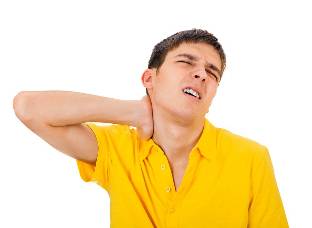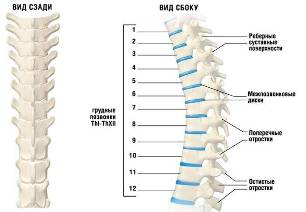At the present time, according to data of health statistics, on the symptoms of cervical osteoarthritis complain almost all the people over the age of 25-30 years. The disease affects the department of the spine most often. The pathology is a progressive degenerative process affecting the intervertebral disks and the vertebrae located in the neck. The disease is prevalent among men and among women also. It is dangerous and a form of complicated degenerative disease of the disk, as well as in the neck are the blood vessels that supply the brain, and a large number of nerve endings. The violation of innervation and blood circulation lead to deterioration of the software of the brain with oxygen and nutrients.

The signs of the disease
The symptoms of degenerative disc disease of the cervical spine occur more marked than in other parts of the spine, same with damage. This is due to the fact that, in the neck, the vertebrae are located in close proximity to each other and the intervertebral disks have a small height. This anatomical features contribute to osteochondrosis most often are tight, the nerve endings in the spinal cord, the blood vessels.
The common symptoms are:
- the pain syndrome;
- the weakness and the decreased sensitivity in the upper limbs;
- the limitation of neck mobility;
- disorders of coordination of movements;
- frequent dizziness;
- the general weakness;
- the deterioration of the functioning of the organs of perception (hearing, sight, touch, taste).
The pain is more often localized in the neck, give the neck, shoulders, arms. The upper limbs are painful, if damaged the vertebra underlying trapped nerve root responsible for their sexuality. The pain in the nape of the neck, are the contribution spastic contractions of the muscles of the neck, attached to the occipital bone, and the violation of blood circulation in this area.
The weakness in the hands can occur in patients, if the disease process involves the nerve root, ensuring the sexuality of the muscle structures of the upper limbs. The limitations of the mobility and the characteristic crackling during the rotation or the tilt of the neck occur if the cervical vertebrae appear bony growths, the height of the intervertebral discs decreases, are amazed at the joints between the vertebrae of the spine.
The cervical vertebrae are the transverse shoots, formants channel through which pass the artery that feeds the brain. Osteochondrosis cervical vertebrae are displaced, they increases the connective tissue. This causes the clamping of the cervical artery, the deterioration of the blood supply of the cerebellum and the rear services of the brain. As a result, the man of frequent dizziness, broken coordination of movements, general weakness. In advanced cases, if the artery is involved in the pathological process or severely pinched, then blood supply of the cerebellum, the part occipital and brain stem deteriorates considerably. In this case, the decline of the functionality of the organs of hearing, sight, there is numbness of the tongue, the fingers.
The signs of the disease depend on eight vertebrae struck by degenerative or an inflammatory process. Of sensitivity disorders and movement lead to damage the spinal roots, which have an impact or the other of the vertebrae. According to this, there are the manifestations of cervical osteoarthritis:

- the first vertebra – numb neck and occipital of the head, decreases their sensitivity;
- the second is to feel the pain in the region of the crown and the nape of the neck;
- the third is felt pain and a reduced sensitivity to the part of the neck, where is stuck in cerebrospinal strain, reduce the intensity of the taste sensations, present speech disorders;
- the fourth, the pain radiating to the shoulder, the scapula, the patient and disturb heart pain, breathing problems, decreases the tonus of the musculature of the neck;
- the fifth – the sensation of pain are shown in the neck, give to the external surface of the shoulder;
- sixth – the pain in the neck radiating to the scapula, can be felt in the forearm and the big toe;
- sorrows make in the shoulder blades, the back part of the shoulder, the forearm and the fingers of the hand (from the second to the fourth);
- the eighth to the pain apply from the neck to the shoulder, forearm and the Ear.
In terms of the prevalence of lesions vary four degrees of degenerative disc disease of the cervical spine. This is not the stage of the disease and the severity of the symptomatology due to the fact, what is the frequency of the disease process, the vertebrae of the spine it touches.
- During the first measurement, clinical symptoms are absent or occur the lowest. Patients complain about the slack the strong sensations with the movements of the head. Effective the treatment started at this stage of the disease. However, people often neglect the symptoms of anxiety or do not feel, that is why your doctor are not.
- The worsening of the disease improves the symptoms. During the second phase, the pains of economic more pronounced, give in the upper limbs, the shoulder-blade. At this stage of development the degenerative process of the height of the disc decreases, so that entrapments nerve fiber. It is and becomes the cause of intensification of the pain. For the second degree of the degenerative disc disease of the cervical spine characterized by the appearance of headaches, malaise, decreased performance.
- The third degree of the cervical osteoarthritis is different from training to be the victim of a herniated disc. The mobility of the neck is limited to the palpation, the patient feels expressed by the pain. During the dissemination of the pathological process of the pain of economic standing, beaming in the upper limbs. Feel the tension of the muscles attached to occipital bone. The patients complain of frequent dizziness, general weakness, numbness of the hands.
- The fourth degree of cervical arthritis is diagnosed when the intervertebral disc protrudes up and completely destroyed the degenerative process. It is replaced by fibrous tissue, which causes a limitation of mobility. Amazed of the spinal cord and runs in the neck blood vessels. These changes are characterized by the significant deterioration of the vascularization of the cerebellum and the occipital lobe of the brain. The oxygen deprivation causes a disruption of the coordination of movements, problems with hearing, sight, numbness of the tongue, speech disorders.
The methods of treatment
Quick access to a doctor at the first symptoms alarming, discomfort in the neck, from the reaction of the nervous system will prevent the progression of the degeneration. The treatment of cervical osteoarthritis is a complex of therapeutic measures. Among them:
- medications;
- massage;
- physiotherapy;
- of the physiotherapy.
Drug therapy
Doctors prescribe anti-inflammatory drugs to reduce the intensity of the pain, reduce the inflammation and swelling of the nerve root. Chondroprotectors repair the tissue damaged cartilage in intervertebral disc. The muscle relaxants to relax the neck muscles, relieve spasms. Medication to improve blood circulation help to renew the blood supply of the brain. The vitamins activate the metabolism of the tissues. In intense sensations of pain the doctor may prescribe pain medications. If the patient expressed pain syndrome, this pain-relieving drugs are introduced by the parenteral route, after the pain calm down, pass on the pills.
Physiotherapy
Physiotherapy is an effective way to fight the osteochondrosis of the cervical spine. Treatment of the disease are still using these methods, after which are obtained the following results:
- reduce the intensity of the pain;
- enabled conservator affected with bone, cartilage and muscle tissue;
- removed spasm and tension in the muscles;
- stopped by the inflammatory process;
- improves the delivery of oxygen and nutrients to the affected area and the brain.
The most effective in the treatment of degenerative disc disease are the following types of procedures:
- officinalis gel electrophoresis (on the affected area suffer an electric shock, which, in addition to the intensification of the blood circulation and tissue repair it improves the delivery of the active substance of a drug to be struck by a degenerative process tissues);
- ultrasound therapy (controlled by exchange processes in the sector, sick, reduces pain, inflammation has stopped);
- the magnet therapy (relieves the swelling of the affected area, which helps to reduce the intensity of the pain);
- laser therapy (improves the blood circulation in the area of the pathological process, is anti-inflammatory).
Physiotherapy
The exercises are named in a period where cropped of the acute manifestations of the disease. At the gym should not be felt in the discomfort and pain. Perform the complex should be the achievement of remission stable for relapse prevention.

- Take position, lying on stomach, lift the head and the body, relying on the hands. Back straight, breathing deep and soft. Stay in one position for a minute or two, and then rush to take a position of origin. The number of repetitions – 3.
- Lying on the stomach, arms along the body. Turn head slowly, trying to touch the ear to the ground. Repeat 6 times on each side.
- Sitting or standing, on the inhalation, tilt the head, trying to reach the hand on the chin to the chest. Exhale marc divert the head back, lifting my eyes to the ceiling. The number of repetitions from 10 to 15.
- A good exercise for strengthening the muscles of the neck – put the pressure on the forehead pressed to her hands. To obtain an effect of the need for support and the palms of his hands on the front, and the front of the palm of the hand within 30 seconds. Repeat three times.
- Turning the head to the circle. Do an exercise slowly, smoothly. On each side of 10 rounds. It is an unacceptable aspect of vertigo during the execution of movements. If this occurs, you must immediately stop.
Massage
The courses are prescribed by a physician, in the absence of acute pain, can only specialist medical education. If this disease is not recommended to apply to non-professionals.
The therapeutic effects of massage of the area:
- improves the circulation of blood and lymph in the affected area;
- relaxes muscles, relieves spasms;
- decreases the intensity of the pain.
Surgery
Surgery is indicated if conservative treatment does not give results within a period of six months, the patient is tormented by pain, signs of damage to nerve fibers and myelopathy. If the osteochondrosis of the cervical spine occurs with complications, there is a risk of stroke, we observe a strong compression of the spinal cord, need an operation.
According to the indications of the use of certain types of surgical procedures:
- discectomy endoscopic – removal of part or all of an intervertebral disc;
- the laminotomy – excision of the bones and ligaments of charges particles of bone (often combined with laminoplasty – establish artificial plates to widen the spinal canal);
- laser vaporization disc of the nucleus, breakage of the nucleus of the intervertebral disc is a laser beam at the time of the destruction of its destroyed fragments;
- cold plasma nucleoplasty – instead of an endoscope used a long, thin hollow needle, which is introduced into the intervertebral disc protrudes up through it, to the place of the lesion portion of the electrode, which is the cold plasma impact.
Neck – a complex organ, in which pass the large blood vessels, spinal cord. Their easy to damage, therefore, of the operational capability of the inputs is not more than 5% of cases. Surgical treatment is often accompanied by the development of complications. Among them:
- the inflammatory process in the tissue or the envelopes of the spinal cord;
- osteomyelitis;
- the formation of the scar, which leads to arterial narrowing and cord pinire channels.
Operations on the cervical spine are complex and require a long recovery phase. The recovery of a patient after a surgical procedure lasts for a period of six months or more.
Prevention
To prevent the development of cervical osteoarthritis, you need to:
- track the position of the spine and the neck;
- lead an active lifestyle, move more;
- in doing physical exercise, you have to be careful, to respect the correctness of the execution, so that even minor injuries can have an impact on the state of the musculoskeletal system;
- take care of the correct position of the body during sleep, buy orthopedic or mattress anatomical;
- to equip a work area where the person spends a lot of time;
- engaging in regular physical activity;
- follow the diet, to ensure the delivery of all the mineral substances necessary for the fortress of bone, in particular magnesium and calcium;
- constantly pass dispensary survey to detect the degenerative disease of the disc.
Prevention will help to prevent the degenerative changes of the cervical spine, protects the pain, dizziness, numbness of the limbs, and other unpleasant symptoms.





























